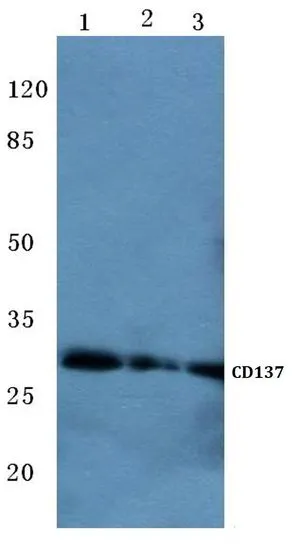
WB analysis of various samples using GTX66655 CD137 antibody. Lane1 : Hela cell lysate Lane2 : sp2/0 cell lysate Lane3 : H9C2 cell lysate Dilution : 1:500
CD137 antibody
GTX66655
ApplicationsWestern Blot
Product group Antibodies
TargetTNFRSF9
Overview
- SupplierGeneTex
- Product NameCD137 antibody
- Delivery Days Customer9
- Application Supplier NoteWB: 1:500-1:1000. *Optimal dilutions/concentrations should be determined by the researcher.Not tested in other applications.
- ApplicationsWestern Blot
- CertificationResearch Use Only
- ClonalityPolyclonal
- Concentration1 mg/ml
- ConjugateUnconjugated
- Gene ID3604
- Target nameTNFRSF9
- Target descriptionTNF receptor superfamily member 9
- Target synonyms4-1BB, CD137, CDw137, ILA, IMD109, tumor necrosis factor receptor superfamily member 9, 4-1BB ligand receptor, CD137 antigen, T cell antigen ILA, T-cell antigen 4-1BB homolog, homolog of mouse 4-1BB, induced by lymphocyte activation (ILA), interleukin-activated receptor, homolog of mouse Ly63, receptor protein 4-1BB
- HostRabbit
- IsotypeIgG
- Protein IDQ07011
- Protein NameTumor necrosis factor receptor superfamily member 9
- Scientific DescriptionThe protein encoded by this gene is a member of the TNF-receptor superfamily. This receptor contributes to the clonal expansion, survival, and development of T cells. It can also induce proliferation in peripheral monocytes, enhance T cell apoptosis induced by TCR/CD3 triggered activation, and regulate CD28 co-stimulation to promote Th1 cell responses. The expression of this receptor is induced by lymphocyte activation. TRAF adaptor proteins have been shown to bind to this receptor and transduce the signals leading to activation of NF-kappaB. [provided by RefSeq, Jul 2008]
- Storage Instruction-20°C or -80°C,2°C to 8°C
- UNSPSC12352203



